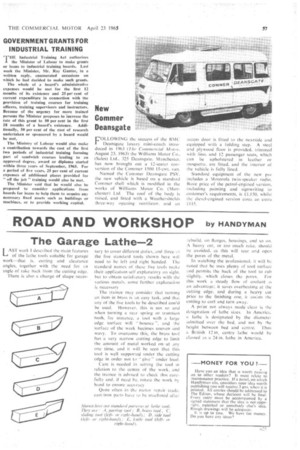ROAD AND WORKSHOP by HANDYMAN
Page 59

If you've noticed an error in this article please click here to report it so we can fix it.
The Garage Lathe 2
I AST week I described the main features of the lathe tools suitable for garage work—that is, cutting and clearance angles, together with the need for an angle of rake back from the elating edge. There is also a change of shape neces sary to cover dilferen1 duties, and three (..1 the five standard tools shown here will need to he left and right handed. The standard names of these live tools make their application self explanatory on sight. but to obtain satisfactory results with the varirms metals. sonic further explanation is necessary The trainee may consider that turning an item in brass is in easy task. and that any of the five tools to be described could be used. However, this is not so and when turning a rear spring or trunnion bush, for instance, a tool with a large
edge surface will bounce ", and the -Surface of the work beelines uneven and wavy. To overcome this, the brass tool has a very narrow cutting edge to limit the amount of metal worked on -at any one time. and it will be seen that this tool is well supported under the cutting edge in order not to " give " under load.
Care is needed in setting the tool in relation to the centre of the work, and the trainee is advised to check this carefully and, if need be. rotate the work hv hand to ensure accuracy Quite often in th motor repair trade. cast-iron parts have to be machined after rebuild, on flanges, housings, and so on. A heavy cut, or too much rake, should be avoided, as this will tear mid open the pores of the metal.
In watching the 'professional. it will he noted that he uses plenty of tool surface and permits the back of the tool to rub slightly, which closes the pores. For this work a steady flow of coolant is an advantage; it saves overheating at the cutting edge, and during a heavy cut prior to the finishing one, it ass:sts the cutting to curl and turn away.
A point not always made clear is the designation of lathe sizes. In America. a lathe is designated by the diameter admitted over the bed, and not by the height between bed and conire. Thus a British 12 in, centre lathe would he classed as a 24 in. lathe in America.




































































































































